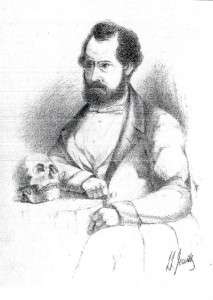Thomas Bateman
| Thomas Bateman | |
|---|---|
%2C_and_His_Son%2C_by_Thomas_Joseph_Banks%2C_sheffield_museums%2C_uk.jpg) Thomas Bateman (1821–1861), and His Son, William Thomas Bateman, by Thomas Joseph Banks Courtesy of sheffield museums, uk | |
| Born |
November 8, 1821[1] Rowsley, Derbyshire |
| Died |
August 28, 1861 (aged 39)[1] Lomberdale House |
| Occupation | Archaeologist |
| Spouse(s) | Sarah |
| Children | 4 |
| Parent(s) | William and Mary Bateman |
Thomas Bateman (8 November 1821 (baptised) – 28 August 1861) was an English antiquary and barrow-digger.
Biography
Thomas Bateman was born in Rowsley, Derbyshire, England, the son of the amateur archaeologist William Bateman. After the death of his father in 1835, Bateman was raised by his grandfather, and from the age of 16 he helped run the family estate at Middleton Hall in Middleton-by-Youlgreave, during which he became interested in archaeology: Sir Richard Colt Hoare's Ancient History of North and South Wiltshire influenced him greatly. Bateman had a long affair with Mary Ann Mason, but she was already married. He married Sarah Parker on 2 August 1847 and they had four daughters and a son.[2]

Bateman's first archaeological experience was observing the demolition of a medieval church in Bakewell. He joined the British Archaeological Association in 1843 and in 1844, whilst at an archaeological congress in Canterbury, participated in the excavation of barrows in the surrounding countryside. The following year he excavated 38 barrows in Derbyshire and Staffordshire, earning himself the nickname "The Barrow Knight".

In 1847 he published Vestiges of the Antiquities of Derbyshire which united his work with that of earlier excavators in the area. He continued to excavate barrows, 50 in the period 1848–1849 and a further 22 between 1851 and 1861, when he died. His second book was Ten Years' Diggings in Celtic and Saxon Grave Hills in the Counties of Derby, Stafford and York, published in the year of his death and it had the details of his work including Heath Wood barrow cemetery.[3]

After his death, his son sold most of Bateman's collections, parts of which were acquired by the Sheffield City Museum (now called the Weston Park Museum) in 1893, including the celebrated Benty Grange helmet. His daughter Clara Theodora Bateman married Sir Harcourt Clare who was Clerk to Liverpool City council and later to Lancashire County Council. Clara and her daughter Dorothy were well known for showing lap dogs and resided at Bank Hall in Lancashire.[4]
In 2006, a bequest allowed Derby Libraries to purchase a collection that had been amassed by Bateman by inserting documents he had found into the four volumes of Lysons Magna Britannia, Derbyshire. Amongst the prints was an image of his museum at his home which is dated from around his death.[5]
Publications
- Vestiges of the Antiquities of Derbyshire, and the Sepulchral Usages of Its Inhabitants (1848), with Stephen Glover
- A Descriptive Catalogue of the Antiquities and Miscellaneous Objects Preserved in the Museum of Thomas Bateman (1855)
- Ten Years' Diggings in Celtic and Saxon Grave Hills, in the Counties of Derby, Stafford, and York (1861)
References
- 1 2
 "Bateman, Thomas (1821-1861)". Dictionary of National Biography. London: Smith, Elder & Co. 1885–1900.
"Bateman, Thomas (1821-1861)". Dictionary of National Biography. London: Smith, Elder & Co. 1885–1900. - ↑ Margaret O'Sullivan, ‘Bateman, Thomas (bap. 1821, d. 1861)’, Oxford Dictionary of National Biography, Oxford University Press, 2004; online edn, May 2006 accessed 21 Nov 2015
- ↑ Ten Years' Diggings in Celtic and Saxon Grave Hills in the Counties of Derby, Stafford and York, Thomas Bateman
- ↑ Bank Hall Action Group (2005) "The Bank Hall Diary and Documents", Pages 61-63.
- ↑ Print of St Alkmund's church, 1750, Picture the past
- Marsden, B.M., 2007, The Barrow Knight, Ryestone Books ISBN 0-9509999-5-4
External links
-
 Works written by or about Thomas Bateman at Wikisource
Works written by or about Thomas Bateman at Wikisource
| Wikimedia Commons has media related to Thomas Bateman. |